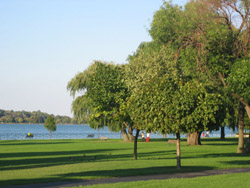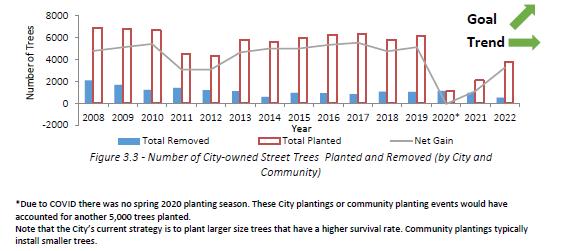Quality of Urban Forest Canopy
Objective C8: Protect and Enhance the Quality and Condition of our Urban Forest Canopy
The following actions are needed to complete this objective:
- Update the street inventory of all City-owned trees along the right-of-way to better understand the health, structure and biodiversity of our urban forest. This will also help identify the gaps and open areas void of trees, as well as high-risk trees, in order to reduce risk, personal injury and damage claims.
- Assess our urban forest and canopy cover by developing a Strategic Urban Forest Management Plan to better understand the environmental goods and services that our urban forest provides.
- Increase the tree canopy cover of the city by setting a new target for canopy cover through the planting and tending of newly planted trees.
- Develop Official Plan policies for new development to require mitigation and compensation for the loss of urban forest vegetation.
- Naturalize and expand our urban forest and canopy cover using native species where appropriate.
- Create incentives for the planting of native tree species and the preservation of existing trees, for example:
- Encourage species diversification and lead by example through our various tree planting events with local partners.
- Launch a “tree drive” by encouraging companies to donate trees and celebrate the achievements we have made with other corporate sponsors.
- Communicate with developers who approach the City in order to preserve trees.
- Work with Forests Ontario’s Heritage Tree Program to identify large and historic trees.
- Promote the planting of flowering trees, fruit trees, or pollinator tree species where appropriate.
- Explore the potential for a private tree cutting by-law, as well as the effectiveness of other municipal tree cutting by-laws.
These indicators show the progress the City is making to achieve this objective:
- City-owned trees planted and removed
- Private tree cutting by-law
City Owned Trees Indicator
The City of Windsor continues to encourage the planting of trees throughout the city. The City's Forestry Division is responsible for planting and maintaining street, boulevard and park trees throughout the city.

The planting of urban trees provides residents with many benefits:
- Trees improve air quality, especially in the summer when air quality is often impaired. Trees filter particulates and absorb carbon dioxide, carbon monoxide, ozone, sulphur dioxide, nitrogen oxides, airborne ammonia and heavy metals while releasing oxygen.
- Trees absorb carbon dioxide, the primary greenhouse gas; however, you need about 500 full-sized trees to absorb the carbon dioxide produced by a typical car driven 20,000 kilometres per year.
- Trees may act as a natural windbreak, reducing residential heating costs by 10 to 15 percent.
- Trees planted near a building will help shade the building in the summer, reducing air conditioning demand.
- Trees intercept rainfall and reduce urban run-off into sewers, improving water quality.
- Trees prevent soil erosion, reducing the need for fertilizers.
- Trees preserve and increase the diversity of plants and animals (biodiversity), which in turn improves the overall health of the community ecosystem.
- Trees can be planted to link natural areas together, providing pathways for wildlife.
- Trees improve the look of an area and have the proven ability to improve someone's mood.
- Trees can increase property values.
How are we doing?
The City of Windsor currently maintains between 65,000 and 75,000 street trees and an unknown number of trees located in parks and natural areas.

As shown in the chart above, the net difference between the number of City-owned street trees planted and removed has increased since 2008.
Note: A large amount of trees were planted in 2008, 2009 and 2010 to counteract the loss of many Ash trees killed by the Emerald Ash Borer.
Note: Due to COVID, there was no spring 2020 planting season. These City plantings or community planting events would have accounted for another 5,000 trees planted.
Note: The City's current strategy is to plant larger-sized trees that have a higher survival rate. Community plantings typically install smaller trees.
What is the City of Windsor doing to increase the number of trees?
- The City of Windsor operates two tree nurseries. Trees to be planted in the city are grown from seed or saplings here in the City of Windsor, reducing long-distance travel of heavier trees.
- Where possible, native tree species are planted in City of Windsor parks and public areas. These species can include, but are not limited to, hackberry, tulip tree, red oak and Kentucky coffee tree. A concerted effort to plant native species has taken place along the waterfront. To increase the genetic diversity of our urban forest, non-native and ornamental trees are also planted.
- Innovative projects, such as using a trenchless "pipe bursting" technology to replace pipeline adjacent to the Ojibway Prairie Complex allowed for a significant number of mature oak trees to be saved. If the pipeline was replaced using traditional methods, these trees would have had to be cut down.
What can you do to increase the number of trees in the City of Windsor?
- Plant a tree or more on your property.
- Encourage a friend, co-worker or business to plant a tree.
- Participate in a tree planting in your community.
